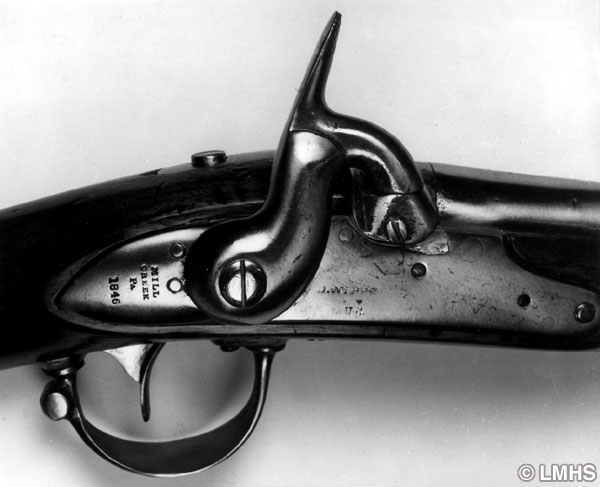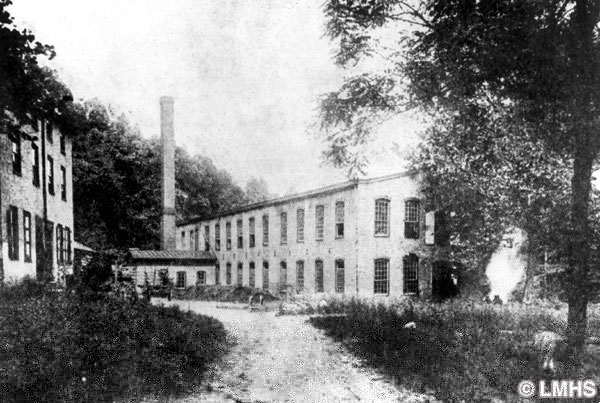Powder Mills and Gun and Metal Works
One of the most difficult mills to locate in the landscape are gun powder manufactories. Maps and deeds identify owners; newspaper reports of the times tell sad tales of explosions and deaths, but none of these fully identifies the locales.
During the Revolution a Jacob Losch, powder maker of Lower Merion, wrote the Council of Safety on March 14, 1777 that following an agreement made with the state to manufacture gunpowder, he had completed a mill and works at the cost of 400 pounds. He complains the government has not supplied him with sufficient funds to relieve his debt, and that he has “the mortification that now when the water is plenty he has not a sufficiency of salt peter and brimstone — That he has been and laid himself under great expenses in building said Mill — has a large family to maintain who as well as himself must be great sufferers unless some assistance shall be given him.” No results for his request nor his mill have been found.
Nippes Mill
Another powder maker was George Keyser. His site has been identified by eventually becoming the Nippes rifle manufacturing mill. In 1800 Keyser purchased acreage for 1,400 pounds from the John Roberts’ estate along Mill Creek from a Benjamin Brooke, forge owner in Gulph Mills. Within a year the site was sold back to Brooke at a sheriff’s sale for only 1,000 pounds. A residence and mill are listed in the deed, but one wonders if an explosion may not have occurred to reduce the price and force such a quick sale.
The subsequent sale of this property by Brooke to J. Abraham Nippes, gunsmith of Northern Liberties for $4,000 in 1807 established the beginning of a long tenure of manufacturing at this mill just west of the intersection of Rose Glen and Mill Creek Roads. The site developed into the long-functioning Barker’s Woolen Mill. Today most buildings still stand serving various businesses and light industry.
The Nippes family (J. Abraham, Anna, and son David) began the production of guns for the U.S. Government here as early as 1807. In 1823, after Abraham had died, the mill was sold to son David. The Nippes’ manufactory produced guns with the initials of D.N. through 1865 when David died.


Associated with this mill site are three significant, roofless stone buildings now part of Rolling Hill Park. One is east of the mill near the creek and may well have been the dwelling house for the owner. The other two are west of the mill, set on a raised earthen and terraced platform. The oldest building is a two story double unit, each with an attached one story kitchen. The second building is a later double dwelling.
Daniel Nippes’ estate was settled in 1881 by selling 65 acres of his property with the mill at an auction. The buyer was William Booth who ran the mill with his half brother, Thomas H. Barker, and converted it to a carpet and rug yarn manufactory. The date stone on the creek facade of the mill states “Wm. Booth Roseglen Mill 1886.” In 1924 the mill was sold to William A.L. Barker who died two years later. Thomas H. Barker II purchased the mill and ran it as the Thomas H. Barker & Co. Inc. Carpet Yarn Mill until 1956. The success of the mill, run by over 60 employees, has been attributed to the use of a metal water wheel or turbine installed in 1890.
Croft Mill
Another manufacturer of metal products on Mill Creek was Samuel Croft, from Birmingham, England. His Philadelphia gilt button business was so successful that he used the capital to build a rolling mill for the production of sheet brass and German silver across from the Roberts Grist Mill. The year 1840 carved on a stone gate post of Croft’s Kettle Mill identifies its construction date. The mill building is now a residence.
Croft also owned the Dove Mill site. Here, in 1873, he built a dam that impounded the creek to form Dove Lake. Today the original sluice and stone waterway to the mill pond for the Croft Kettle Mill still function, receiving water from the fall at Roberts Mill, the site where the mill industry started over three hundred years ago.
At the intersection of Mill Creek and Old Gulph Roads stands a house known in local lore as “The 1690 House,” the first dwelling of the first John Roberts. Remnants of a log cabin are enclosed within a wall; a plaque, of questionable accuracy, is beneath its peak.
